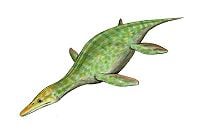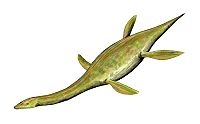Pliosaur
| Pliosaur
| ||||||||||||
|---|---|---|---|---|---|---|---|---|---|---|---|---|
 Peloneustes philarchus
| ||||||||||||
| Scientific classification | ||||||||||||
| ||||||||||||
|
see text |
Pliosaurs were carnivorous, aquatic, Mesozoic-era reptiles comprising the suborder Pliosauroidea of the Plesiosauria order, characterized by a broad body, short tail, and four paddle-shaped flipper limb, and a shorter neck and more elongated head than the closely related "true plesiosaurs" (suborder Plesiosauroidea of the Plesiosauria order). They lived from the Triassic to the Cretaceous periods and, along with the true plesiosaurs, were the largest aquatic animals of their time. They were not dinosaurs.
| Mesozoic era (251 - 65 mya) | ||
|---|---|---|
| Triassic | Jurassic | Cretaceous |
Overview and description
Plesiosauria
The Plesiosauria order, to which the pliosaurs belonged, were aquatic, mostly marine reptiles (superorder Sauroptrygia) with a broad body, short tail, and four paddle-shaped flipper limbs. Plesiosauria first appear in the fossil record in the Middle Triassic. They thrived until the K-T extinction, at the end of the Cretaceous period. Although they lived at the same time as dinosaurs, and though they are often lumped together with the "terrible lizards," they were not dinosaurs.
The limb arrangement of members of Plesiosauria is unusual in aquatic animals and it is thought that they were used to propel the animal through the water by a combination of rowing movements and up-and-down movements. They had no tail fin and the tail was most likely used for helping in directional control. This arrangement is in contrast to that of the later mosasaurs and the earlier ichthyosaurs. There may be similarities with the method of swimming used by penguins and turtles, which respectively have two and four flipper-like limbs.
As a group, the plesiosaurs were the largest aquatic animals of their time, and even the smallest were about two meters (6.5 feet) long. They grew to be considerably larger than the largest giant crocodiles, and were bigger than their successors, the mosasaurs. However, their predecessors as rulers of the sea, the dolphin-like ichthyosaurs, are known to have reached 23 meters (m) in length, and the modern whale shark (18 m), sperm whale (20 m), and especially the blue whale (30 m) have produced considerably larger specimens.
The anteriorly placed internal nostrils have palatal grooves to channel water, the flow of which would be maintained by hydrodynamic pressure over the posteriorly placed external nares during locomotion. During its passage through the nasal ducts, the water would have been "tasted" by olfactory epithelia.
The Plesiosauria order is divided into two suborders, Pliosauroidea and Plesiosauroidea. Members of the Plesiosauria order in general are sometimes called plesiosaurs, as are members of the suborder Plesiosauroidea. The term "true plesiosaurs" can be applied to those belonging to the suborder Plesiosauroidea in order to distinguish them. Members of the Pliosauroidea suborder are known as pliosaurs.
Pliosaurs
The Pliosauroidea and Plesiosauroidea are primarily distinguished by head and neck size. The Plesiosauroidea, such as Cryptoclididae, Elasmosauridae, and Plesiosauridae, had long necks and may have been bottom-feeders, in shallow waters. The neck of Elasmosaurus was very long, twice the length of the body. The Pliosauridae (pliosaurs) had a short neck with large, elongated head and may have been at home in deeper waters. However, in recent classifications, one short-necked and large-headed Cretaceous group, the Polycotylidae, are included under the Plesiosauroidea, rather than under the traditional Pliosauroidea.
In addition to the shorter neck and more elongated head, pliosaurs also were more crocodile-shaped than the members of Plesiosauroidea. Their long and powerful jaws carried many sharp, conical teeth. Pliosaurs fossils indicated a range from 4 to 15 meters in length (Rincon 2008). They were carnivorous and their prey may have included fish, ichthyosaurs, and other plesiosaurs.
The adaptation of having four-flippers is a mystery. No modern animals have this swimming adaptation, so there is considerable speculation about what kind of stroke they used. The short-necked pliosaurs (e.g. Liopleurodon) may have been fast swimmers. However, unlike their pliosaurian cousins, the long-necked true plesiosaurs (with the exception of the Polycotylidae) were built more for maneuverability than for speed, and were probably relatively slow swimmers.
Fossil specimens of pliosaurs have been found in England, Mexico, South America, Australia, and the Arctic region near Norway. The name is derived from the Greek πλειω from the verb meaning "to sail" or πλειων meaning "fin" and σαυρος meaning "lizard."
Pliosaurs originally included were reptiles of the family Pliosauridae, but several other genera and families are now also included; the number and details of which vary according to the classification used. Typical genera include Macroplata, Kronosaurus, Liopleurodon, Pliosaurus and Peloneustes. Many very early (from the Rhaetian (Latest Triassic) and Early Jurassic) primitive pliosaurs were very like plesiosaurs in appearance and indeed used to be included in the family Plesiosauridae.
Taxonomy
The taxonomy presented here is mainly based on the plesiosaur cladistic analysis proposed by O'Keefe in 2001.
- Suborder: †Pliosauroidea Welles, 1943 sensu O'Keefe, 2001
- ? †Bishanopliosaurus Dong, 1980
- ? †Megalneusaurus Knight, 1898
- ? †Pachycostasaurus Cruickshank, Martill & Noe, 1996
- ? †Sinopliosaurus G. Young, 1820
- †Thalassiodracon Storrs & Taylor, 1996
- †Archaeonectrus Novozhilov, 1964
- †Attenborosaurus Bakker, 1993
- †Eurycleidus Andrews, 1922
- Family: †Rhomaleosauridae (Nopsca, 1928) Kuhn, 1961 sensu O'Keefe,2001
- †Umoonasaurus Kear, Schroeder & Lee, 2006
- ? †Yuzhoupliosaurus Zhang, 1985
- ? †Hexatarostinus
- †Rhomaleosaurus Seeley, 1874
- †Simolestes Andrews, 1909
- Family: †Leptocleididae White, 1940
- †Leptocleidus Andrews, 1922
- Family: †Pliosauridae Seeley, 1874 sensu O'Keefe, 2001
- ? †Plesiopleurodon Carpenter, 1996
- ? †Polyptychodon Non Owen, 1841
- ? †Maresaurus Gasparini, 1997
- †Macroplata Swinton, 1930
- †Hauffiosaurus O’Keefe, 2001
- †Kronosaurus Longman, 1924
- †Peloneustes Lydekker, 1889
- †Liopleurodon Sauvage, 1873
- †Brachauchenius Williston, 1903
- †Pliosaurus Owen, 1841
ReferencesISBN links support NWE through referral fees
- Carpenter, K. 1996. A review of short-necked plesiosaurs from the Cretaceous of the western interior, North America. Neues Jahrbuch fuer Geologie und Palaeontologie Abhandlungen (Stuttgart) 201(2): 259-287.
- Everhart, M. J. 2002. Where the elasmosaurs roam. Prehistoric Times 53: 24-27.
- O'Keefe, F. R. 2001. A cladistic analysis and taxonomic revision of the Plesiosauria (Reptilia: Sauropterygia). Acta Zoologica Fennica 213: 1-63.
- Rincon, P. 2008. Sea reptile is biggest on record. BBC News February 27, 2008. Retrieved April 21, 2008.
- White, T. 1935. On the skull of Kronosaurus queenslandicus Longman. Occasional Papers Boston Soc. Nat. Hist. 8: 219-228.
See also
Further reading
- The Plesiosaur Directory - pliosaur page
- Possibly the first full skeleton of a pliosaur was found in October, 2006.
- The monster from the North
Credits
New World Encyclopedia writers and editors rewrote and completed the Wikipedia article in accordance with New World Encyclopedia standards. This article abides by terms of the Creative Commons CC-by-sa 3.0 License (CC-by-sa), which may be used and disseminated with proper attribution. Credit is due under the terms of this license that can reference both the New World Encyclopedia contributors and the selfless volunteer contributors of the Wikimedia Foundation. To cite this article click here for a list of acceptable citing formats.The history of earlier contributions by wikipedians is accessible to researchers here:
The history of this article since it was imported to New World Encyclopedia:
Note: Some restrictions may apply to use of individual images which are separately licensed.




